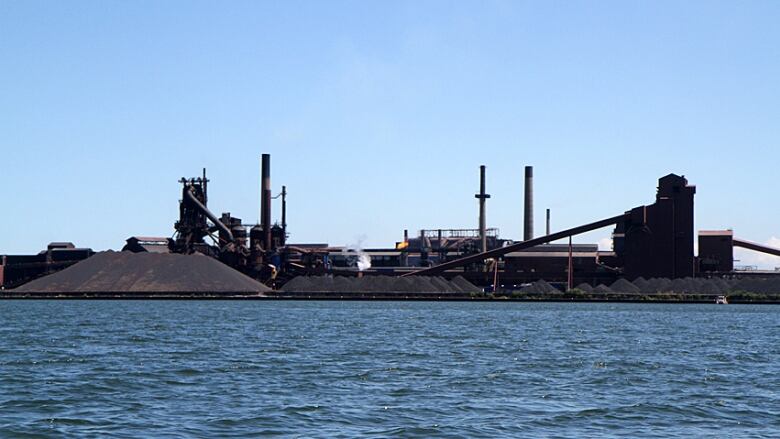Air quality stations disappearing from Hamilton industrial areas

At least two more air monitoring stations have quietly moved or disappeared from northeast Hamilton in the last two years, which local officials worry shows a growing weakness in the network that monitors the city's industrial air quality.
The Ministry of Environment (MOE) pulled an air monitoring station from Hamiltons beach strip in April and moved it elsewhere in Ontario. Hamilton Air Monitoring Network (HAMN) annual reports show that another station near the QEW at Millen Road in Stoney Creek has disappeared since 2012.
This is in addition to theHAMN station in the McAnulty Boulevard area that closed in January after Liberty Energy pulled the money to operate it. ArcelorMittal Dofasco told CBC Hamilton on Thursday that it will step in and fund the station.
But the dwindling number of stations concerns Lynda Lukasik of Environment Hamilton, who worries it signals the potential demise of theHAMN, an air quality monitoring system paid for by local industry. And local politicians are critical of the "cloak and dagger way" they are disappearing with no notice or consultation.
Industry participation in HAMN is voluntary. In the last two years, three companies beyond Liberty Energy have pulled out of HAMN, which meant a loss of $43,000. The network's revenue in 2014 was almost equal to its expenses, Neil Buonocore, HAMN administrator, said in an email late Thursday. So HAMN had to close theMcAnultyBoulevard station.
This is really critical information.- Lynda Lukasik, Environment Hamilton
HAMN's online reporting system is the only reason the air quality information is public, Lukasik said. Her worst fear is that HAMN will fold and the public will no longer have access to real-time data.
This is really critical information, she said. For us as a community to not have access to that kind of information would, to me, be a huge step backward.
The network is down to 17members, and Lukasik says no new ones are coming on board. There are several industries that should, but there's no way to force them.
Many of Hamiltons heavy industries are required to send air quality monitoring reports to the MOE, Lukasik said. But they'renot required to make the information public.
ArcelorMittal Dofasco has stepped in before when more money was needed, spokesperson Marie Verdun said in an email.
Province moved astation out of Hamilton
We support the HAMN and believe that an effective and sustainable network is critical, she said.
HAMN moved its Stoney Creek monitoring station to Gage Avenue, Buonocorewrote.
The MOE, meanwhile, pulled its monitoring station on the beach stripin April. The area was not being significantly impacted by industrial operations and not providing us with additional data about local industrial air pollution, spokesperson Jennifer Hall said.
The station was moved elsewhere in Ontario.
We know that almost 200 people annually prematurely die in Hamilton as a result of poor air quality. Its a contributing factor in someones health.- Coun. Chad Collins
Coun. Chad Collins of Ward 5 didnt know that until told by the CBC. No one tells the city or the public when a station moves, he said.
The trend is going in the wrong direction and it flies in the face of what the public wants."
Hamiltonians dying from air quality issues
Its something that the public has demanded more information on over the last number of years, he said.
We know that almost 200 people annually prematurely die in Hamilton as a result of poor air quality. Its a contributing factor in someones health.
The notion that air quality along the beach strip is not significantly impacted by industry, he added, is an ignorant statement.
HAMN reports the data to the MOE, which is committed to making sure the network works, Hall said.
The ministry will continue to talk with industry to ensure support continues for the network and that there is a strong monitoring program in Hamilton.
Hamilton's air quality 'highly monitored,' province says
The MOE operates three air quality index stations, and HAMN operates 14 in Hamiltons industrial area, she said. The local MOE office does additional air quality testing, including regularly monitoring particulate matter.
That makes Hamiltons air shed one of the most highly monitored in the province.
Local air quality results show Eastport Drive along the beach is the fourth worst area in Hamilton for air quality.McAnultyBoulevard is fifth.
Collins is spending $300,000 of his $1.6-million area rating budgetthis year to buy two mobile monitoring stations. This is in part to make up for a station the province pulled from the Nash Road area in the 1990s.
Coun. Sam Merulla of Ward 4, meanwhile, offered up about $40,000 in his area rating money to run the McAnulty Boulevard station in St. Christophers Park. With ArcelorMittal Dofasco's pledge, he said, that may not be necessary now.
Should be an election issue
The city shouldnt have to pick up the province's slack, Collins said. HAMN participation should be mandatory, and the data should be public.
We seem to be losing (air monitoring stations) in the areas where we need them most, he said, and its done in a cloak-and-dagger way of government.
Theres no correspondence or anything that says, These are the plans.'Theres no consultation with the community.
Hamiltonians should be making it an issue in the June 12 provincial election, Merulla said.
The city is coming forward to fill in a gap in (the provinces) incompetence, he said. It cant continue because we cant afford it.












_(720p).jpg)


 OFFICIAL HD MUSIC VIDEO.jpg)
.jpg)



























































































